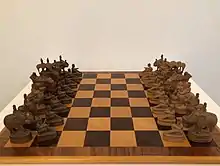Indian chess
Indian chess is the name given to regional variations of chess played in India in the 18th and 19th centuries. It is distinct from chaturanga. There are several such variations, all quite similar to modern rules, with variants regarding castling, pawn promotion, etc. These variants were popular in India until the 1960s. However, even today a mix of Indian and international rules and terminology are used in some parts of India.

Antique Indian chess set depicting elephants, horses and camels
Differences from Western chess
- The king cannot move unless at least one check has been given.
- When only the kings and pawns are left in play, the opponent may not give check, but they can win by stalemate. Alternatively, giving check is allowed, but the capture of the last pawn (which would result in a draw) is disallowed.
- The pawn's two-step initial move is absent in Indian chess; thus, the en passant capture is also absent.
- Normal castling with rook and king is absent. The king can make a knight's move once in a game, known as Indian castling.
- On reaching the opposite end of the board, a pawn is promoted to a piece of the type that began on that square. If it is promoted on the king's initial position, it is promoted a queen.
- If there is one piece remaining other than the kings, it may not be captured. Alternatively, it may be captured unless it is a pawn.
Names of the pieces
The following table describes one version of Indian chess terminology for the various pieces (including Hindi and Urdu pronunciations):[1]
| Standard chess piece | Indian chess piece | |||||||
|---|---|---|---|---|---|---|---|---|
| English | Hindi | Urdu | ISO 15919 | Other | Telugu | Malayalam | Tamil | |
| king | king | राजा | راجا | rājā | రాజు | രാജാവ് | ராஜா | |
| बादशाह | بادشاہ | bādśāh | ||||||
| queen | minister | मन्त्री | منتری | mantrī | మంత్రి | മന്ത്രി | ||
| व़ज़ीर | وزیر | wazīr | ||||||
| queen | बेगम | بیگم | bēgam | None | ||||
| रानी | رانی | rānī | ராணி | |||||
| मलिका | ملکا | malikā | ||||||
| general | सेनापति | سیناپتی | sēnāpati | |||||
| rook | elephant | हाथी | ہاتھی | hāthī | āna[2] | ఏనుగు | None | யானை |
| chariot | रथ | رتھ | rath | rukkha[3] | തേര് | கோட்டை | ||
| knight | horse | घोड़ा | گھوڑا | ghōṛā | గుఱ్ఱము | കുതിര | குதிரை | |
| bishop | camel | ऊँट | اونٹ | ū̃ṭ | None | |||
| bishop | व़ज़ीर | وزیر | wazīr | அமைச்சர் | ||||
| chariot | रथ | رتھ | rath | శకటం/శెగటు | ||||
| elephant | ആന | |||||||
| pawn | infantryman | पैदल | پیدل | paidal | బంటు | കാലാള് | ||
| प्यादा | پیادا | pyādā | കാലാള് / പടയാളി | |||||
| सैनिक | سینک | sainik | പടയാളി | |||||
| सिपाही | سپاہی | sipāhī | None | |||||
See also
- Origins of chess
- Chaturaji, four-handed version of chaturanga
- Shatranj
References
- Cazaux, Jean-Louis. "Indian Chess Sets". Another view on Chess: Odyssey of Chess. Archived from the original on 6 November 2020. Retrieved 25 November 2014.
- Malayalam
- Punjabi
Further reading
- Bhartiya Shatranj [in Hindi] by Dwarka Prasad Gupta. Published by Vangmaya Prakashan, Jaipur
- The History of Chess: from the Time of the Early Invention of the Game in India till the Period of its establishment in Western and Central Europe - The History of Chess: from the Time of the Early Invention of the Game in India till the Period of its establishment in Western and Central Europe
This article is issued from Wikipedia. The text is licensed under Creative Commons - Attribution - Sharealike. Additional terms may apply for the media files.